

They skirted around it on the official doc. They didn’t explicitly say not all 6a devices are affected. They instead say if yours is affected, based on where you got it from and what are the laws in your area, you might be eligible for compensation or free repair.
It is entierly possible that hardware lottery is in play and some batts are feom a different supplyer. From what I gathered.





It’s due for a head gasket change, not much else. Not worth upgrading to a newer car for my price range and use case. I don’t need a computer I don’t own.